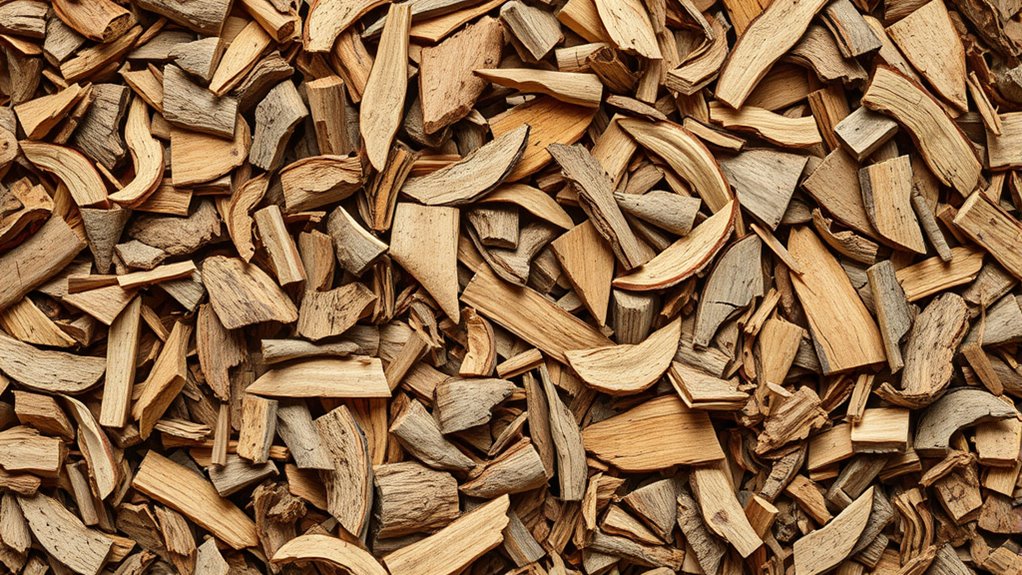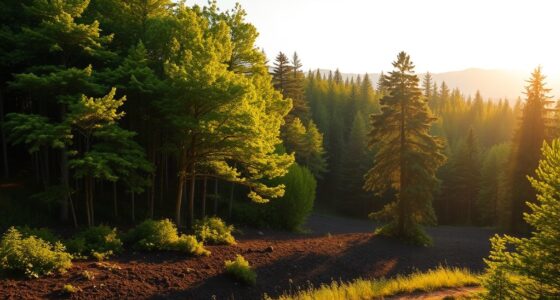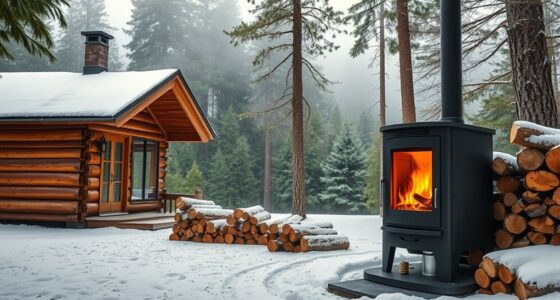Upcycling bark and wood chips transforms waste into valuable resources for your garden and home projects. You can create nutrient-rich compost, natural pest repellents, or decorative pathways that blend seamlessly with your landscape. These materials also make eco-friendly home decor and animal bedding, reducing landfill waste while boosting sustainability. With some simple techniques, you turn scraps into functional and beautiful elements. Keep exploring, and you’ll discover more innovative ways to give these natural materials a new life.
Key Takeaways
- Transform bark and wood chips into nutrient-rich compost to recycle waste and improve garden soil sustainably.
- Use shredded bark and wood chips as natural mulch to conserve moisture, suppress weeds, and enhance landscape aesthetics.
- Create natural textured fabrics and decorative art projects by dyeing or embedding bark and wood chips in crafts.
- Repurpose bark and wood chips as animal bedding or habitat materials, promoting eco-friendly pet and wildlife environments.
- Incorporate bark and wood chips into pathways, borders, or scent-infused garden features for sustainable landscaping and pest deterrence.
Creative Garden Mulch and Soil Amendments

Using bark and wood chips as mulch not only enhances the appearance of your garden but also improves soil health. Bark mulch provides a natural, decorative layer that conserves moisture, suppresses weeds, and moderates soil temperature. You can also create a nutrient-rich wood chip compost by layering wood chips with organic scraps, which breaks down into valuable soil amendments over time. This compost enriches your garden beds, promoting healthy plant growth. Applying bark mulch directly on the soil surface reduces erosion and maintains consistent moisture levels. When combined with homemade wood chip compost, it boosts soil fertility sustainably. These upcycled materials serve as versatile, eco-friendly options for maintaining a thriving garden while reducing waste. Additionally, preparing and using the right type of paint in your garden projects can help achieve durable, attractive finishes on garden structures and furniture, enhancing the overall aesthetic and longevity of your outdoor space. Incorporating artistic influences such as textured finishes or color contrasts can further elevate your garden’s visual appeal and create a harmonious outdoor environment. Moreover, understanding soil amendment techniques can optimize the benefits of wood chips and bark mulch, ensuring your garden remains healthy and productive. Recognizing the importance of composting organic materials can also accelerate the breakdown process and improve soil enrichment.
Crafting Unique Home Decor and Art Pieces
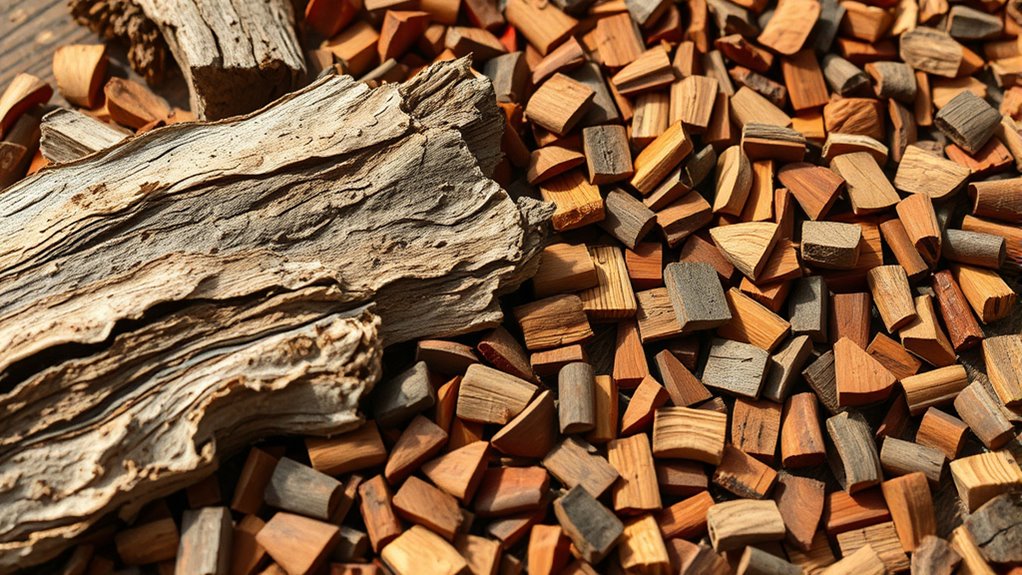
Transforming bark and wood chips into unique home decor and art pieces offers an eco-friendly way to personalize your space. You can use natural textile dyeing techniques with bark to create vibrant, one-of-a-kind fabrics for wall hangings or pillow covers, adding texture and color. Incorporate wood chips into sculptures or framed artwork, highlighting their natural beauty and grain patterns. Enhance your decor’s ambiance by adding aromatherapy scents to bark or wood chip arrangements, infusing your environment with calming or invigorating aromas. These sustainable materials allow you to craft meaningful, customized pieces that reflect your style while reducing waste. Incorporating vintage decor elements can further enhance the rustic charm of your creations. Utilizing eco-friendly materials can help ensure your projects remain sustainable and environmentally conscious. When selecting bark and wood chips, consider their safety and durability to ensure your finished pieces last and remain safe for indoor use. Additionally, understanding the cost range of such natural materials can help you plan your projects effectively. Whether you’re designing a statement wall or a cozy corner, upcycled bark and wood chips bring originality, sustainability, and sensory appeal to your home decor.
Building Eco-Friendly Pathways and Borders

Building eco-friendly pathways and borders offers a natural extension of your upcycling efforts, turning bark and wood chips into functional landscape features. By sourcing materials sustainably, you guarantee your project supports environmentally responsible practices. Use bark and wood chips to create winding pathways that blend seamlessly with your garden, providing a rustic, natural look. These materials also serve as attractive borders that define garden beds and walkways while reducing mulch waste. Their organic texture enhances your landscape’s aesthetic, creating a cohesive and inviting outdoor space. Plus, repurposing bark and wood chips minimizes waste and reduces reliance on synthetic materials. With careful placement and layering, you can craft durable, eco-conscious pathways that not only look great but also promote sustainable landscaping. Incorporating local store hours can help you plan your materials shopping efficiently.
Making Natural Pest Repellents and Plants Coverings
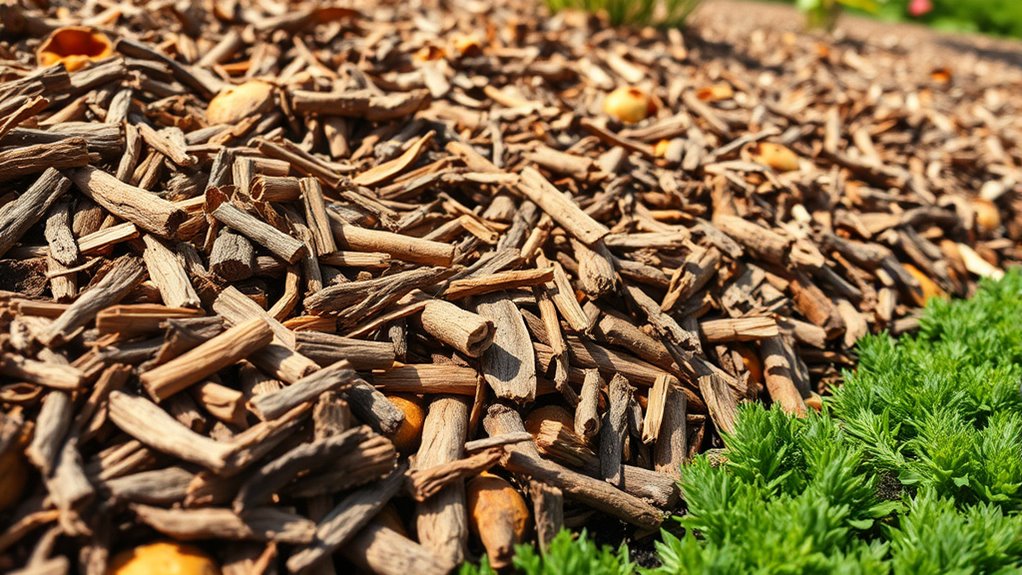
You can turn bark and wood chips into natural pest repellents that protect your garden without chemicals. These mulches also help insulate plants and retain moisture, promoting healthy growth. Exploring how to use them effectively can make your garden more sustainable and resilient. Additionally, applying proper mulch application techniques ensures maximum effectiveness and prevents issues like mold or pests. Incorporating mindful garden practices can further enhance plant health and overall garden vitality. Being aware of Technical Aspects of Emailing and how they relate to communication strategies can also inspire innovative ways to incorporate eco-friendly and sustainable methods into your gardening routine, such as choosing eco-conscious materials and practices for garden maintenance.
Pest Deterrent Qualities
Using bark and wood chips as natural pest deterrents is an effective way to protect your garden without relying on chemicals. When applied as a pest barrier, they help keep pests like slugs, beetles, and ants at bay. The coarse texture discourages crawling insects and creates a physical obstacle, reducing pest access to your plants. Additionally, wood chips act as an insect repellent by releasing natural compounds that repel certain pests. Their scent and chemical properties make them less attractive, helping to minimize infestations. By covering the soil with these materials, you also create an environment less inviting to pests, while promoting healthy plant growth. Incorporating bark and wood chips into your garden is a simple, eco-friendly way to enhance pest control naturally. Using top-rated camping gear such as portable tents and solar panels can also make outdoor gardening and pest management more convenient and enjoyable. Recognizing the influence of AI on gardening trends can help you discover innovative ways to optimize pest deterrents and garden health. In addition, understanding the role of natural compounds in wood and bark can further improve their effectiveness as pest repellents. Exploring regulatory considerations related to natural pest control methods can ensure safe and sustainable gardening practices.
Mulching and Insulation
Applying bark and wood chips as mulch not only protects soil moisture and temperature but also creates a natural barrier against pests. Their bark coloration and unique wood grain patterns add visual appeal while insulating plant roots. You can use these materials to make natural pest repellents or cover plants, reducing chemical use. For example, finely shredded bark repels insects, while larger chips deter larger pests. The variety in bark coloration and wood grain patterns allows you to customize your garden’s look. Additionally, selecting aromatic bark can enhance pest deterrence through natural scents. Incorporating aesthetic qualities into your garden design can make the space both functional and visually appealing. Using natural pest repellents like these reduces the need for synthetic chemicals and promotes a healthier garden environment. Emphasizing creative practice in your garden design can inspire innovative ways to combine function and beauty.
Creating Compost and Organic Fertilizers
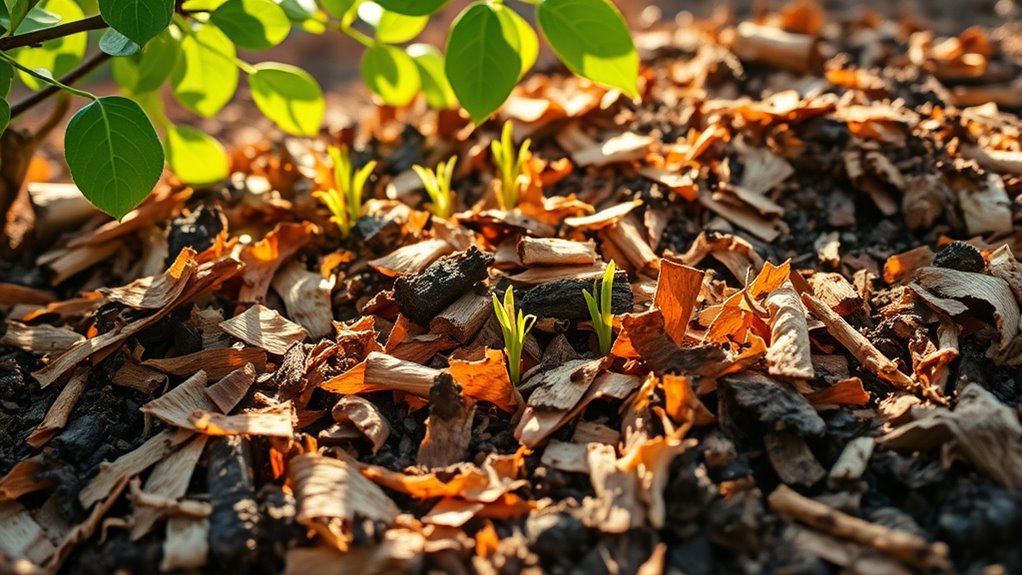
Creating compost and organic fertilizers is a great way to enrich your soil naturally. You can use bark and wood chips to build a nutrient-rich compost or craft fertilizers with simple techniques. These methods boost plant health while reducing waste, making your garden more sustainable.
Composting Benefits and Methods
Composting transforms bark and wood chip waste into valuable organic fertilizers that boost soil health and plant growth. This process supports sustainable waste management by reducing landfill contributions and repurposing organic materials. When you compost, you’re facilitating nutrient recycling, turning what would be waste into rich humus that enriches your soil naturally. To start, layer your wood chips and bark with nitrogen-rich materials like kitchen scraps or grass clippings. Maintain proper moisture and aeration to encourage microbial activity. Turning the compost regularly accelerates decomposition and prevents odors. Composting not only minimizes waste but also creates a nutrient-dense soil amendment that promotes healthy plant development. By adopting composting methods, you contribute to environmental sustainability and access the full potential of bark and wood chips as organic fertilizers.
Organic Fertilizer Production Techniques
To produce effective organic fertilizers from bark and wood chips, you need to follow specific techniques that harness natural decomposition processes. Understanding bark nutrient content helps you optimize composting efforts, as some barks are richer in nutrients than others. Wood chip composting involves layering your materials properly, maintaining a balanced carbon-to-nitrogen ratio, and turning the pile regularly to ensure even decomposition. Incorporate green materials like kitchen scraps or grass clippings to boost nitrogen levels. Keep the compost moist but not soaked, and monitor temperature to prevent pests. Over time, the bark and wood chips break down into nutrient-rich humus, creating a natural fertilizer that enhances soil health. Properly managed, this process transforms waste into a valuable resource for your garden.
Repurposing for Animal Bedding and Habitat Designs
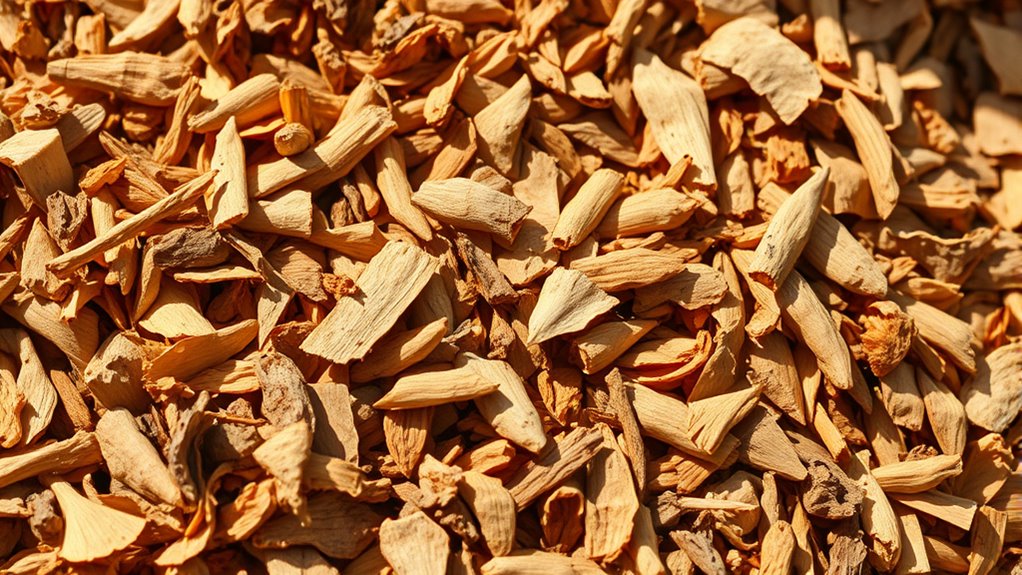
Repurposing bark and wood chips for animal bedding and habitat designs offers practical and eco-friendly solutions for pet owners and conservation efforts alike. Using these materials creates comfortable animal habitats while reducing waste. As bedding materials, bark and wood chips absorb moisture and control odors, promoting healthier environments. They’re also ideal for creating naturalistic enclosures that mimic wild habitats.
- Enhance animal comfort through natural insulation
- Reduce landfill waste by upcycling materials
- Support sustainability in habitat design
Frequently Asked Questions
What Are the Environmental Benefits of Upcycling Bark and Wood Chips?
You can help the environment by understanding the benefits of upcycling bark and wood chips. They promote carbon sequestration, reducing greenhouse gases in the atmosphere. Additionally, using these materials enhances habitats for wildlife, supporting biodiversity. By repurposing bark and wood chips, you decrease waste, lower the need for synthetic mulch, and contribute to sustainable land management. This simple action benefits ecosystems and combats climate change, making a positive impact for future generations.
How Long Does Upcycled Bark and Wood Chips Typically Last Outdoors?
You might wonder how long upcycled bark and wood chips last outdoors. Their longevity depends on factors like decomposition rate, moisture, and climate. Typically, they can last from one to three years before breaking down considerably. To extend their lifespan, guarantee proper placement, avoid excessive moisture, and use thicker layers. Understanding these longevity factors helps you maintain a healthy, eco-friendly outdoor space with minimal replacement needs.
Are There Any Safety Concerns When Using Wood Chips Around Pets?
You might find yourself worried about pet safety when using wood chips, especially if you notice your furry friend nibbling nearby. While natural wood chips are generally safe, toxicity concerns arise with certain types like cedar or pine, which can irritate your pet’s respiratory system or digestive tract. Always verify proper identification of the wood, avoid treated varieties, and monitor your pets to prevent accidental ingestion or irritation, prioritizing their safety.
Can Upcycled Bark and Wood Chips Help Improve Soil Health?
You can definitely improve soil health by using upcycled bark and wood chips, as they promote soil enrichment and enhance moisture retention. These organic materials break down slowly, releasing nutrients that nourish plants and support beneficial microbes. Plus, they help retain soil moisture, reducing watering needs. This sustainable approach not only benefits your garden’s ecosystem but also gives waste a new purpose, making your gardening practices more eco-friendly.
What Types of Trees Produce the Best Bark and Wood Chips for Upcycling?
When choosing tree species for bark and wood chips, focus on those with high-quality bark. Hardwoods like oak, maple, and hickory typically produce better bark for upcycling due to their density and durability. Softwoods such as pine and cedar can also work but may break down faster. You’ll want bark with minimal defects or pests, ensuring the chips are clean, nutrient-rich, and suitable for improving soil health.
Conclusion
Think of upcycling bark and wood chips as tending a vibrant, ever-growing garden. With each creative use, you’re nurturing a tiny ecosystem that sustains beauty and harmony. Your efforts transform raw materials into treasures, like a gardener turning soil into a lush paradise. Embrace this journey, and watch your eco-friendly projects flourish like a well-tended garden—where every chip and bark piece plays a crucial role in creating a more sustainable world.
